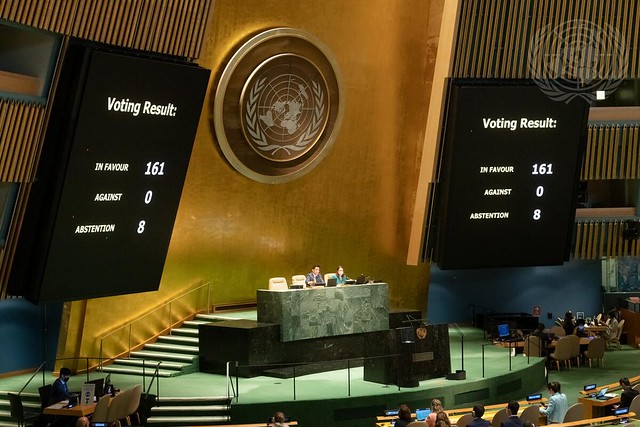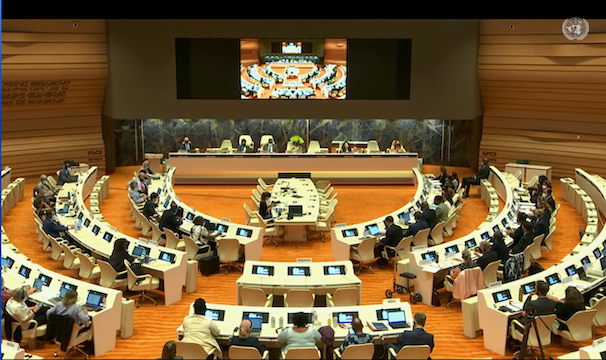Increasing Global Awareness of Violence Against Indigenous Women in the U.S

Peacebuilding & Human Rights by UN Photo/Mark Garten.
International human rights law can provide significant opportunities to raise global awareness about the crisis of violence against indigenous women in the United States—opportunities besides those found in local, tribal, state, and federal fora. “In addition to providing new advocacy spaces to strengthen grassroots efforts to restore safety to Indigenous women and to gain strong federal responses, international advocacy helps Indigenous women and Indigenous organizations in the United States build relationships,” notes Chris Foley, Senior Attorney at the Indian Law Resource Center, “including with other Indigenous women and peoples, with other advocacy organizations, and with human rights bodies and experts that can be helpful in pressuring the United States to meet its human rights obligations.”
Review of United States’ compliance with the International Convention on the Elimination of All Forms of Racial Discrimination
On August 11-12 in Geneva, Switzerland, the Committee on the Elimination of Racial Discrimination (CERD) reviewed the United States’ recent Combined Tenth to Twelfth Periodic Reports concerning its compliance with an important international human rights treaty. While such reports are generally expected from member states every two years, it is a welcome move that the U.S. submitted its Combined Periodic Reports covering three past reporting periods since CERD’s last review of its compliance in 2014.
CERD is a body of experts that monitors the compliance by member state parties with the International Convention on the Elimination of Racial Discrimination, a binding treaty adopted by the United Nations in 1965 and ratified by the United States in 1994. The Convention offers protections for Indigenous women and all other persons against racial discrimination in all its forms. Racial discrimination continues to be a major barrier throughout the world to the complete realization of human rights.
“The Indian Law Resource Center worked collaboratively with several Indigenous women’s organizations on an alternative report, titled “Violence Against Indigenous Women in the United States, including the Crisis of Missing or Murdered Indigenous Women, and Lack of Safe and Adequate Housing for Indigenous Survivors,” says Jana Walker, a Senior Attorney with the Indian Law Resource Center. “CERD encourages such alternative reports from international, regional, national, and local organizations, particularly reports by coalitions, to help it gain a fuller picture of serious human rights matters, in this case the situation of Indigenous women in the United States with respect to violence.” The Alternative Report is posted on the UN Treaty Body Database for CERD’s 107th session at n8ve.net/IfEf4c6q.
The Alternative Report was submitted to CERD by the Alaska Native Women’s Resource Center, the Indian Law Resource Center, the National Indigenous Women’s Resource Center with its project STTARS Indigenous Safe Housing Center, and the Pouhana O Nā Wahine (Pillars of Women).
The Alternative Report pointed out that recent legislative findings show little improvement since CERD’s last Concluding Observations in 2014. Violence against Indigenous women remains at unprecedented levels. The United States’ discriminatory legal system continues to limit Indigenous peoples’ right to protect their women and fails to prevent or respond to crimes and rights violations. As to the pressing crisis of missing and murdered Indigenous women in the United States, the Alternative Report also noted that a recent federal report found that no one even knows how many Indigenous women are missing or murdered.
CERD also held a hybrid informal meeting with NGOs focused on the United States on August 9, 2022, prior to its review of the United States' compliance. Because NGOs are not allowed to speak during the official country review meetings, CERD organized this informal meeting to allow NGOs to present information and highlight key points from their written submissions. Caroline LaPorte, Director, STTARS Indigenous Safe Housing Center, participated in the informal meeting virtually and was able to offer a brief statement on behalf of the organizations collaborating on the alternative report regarding violence against Indigenous women in the U.S. “The United States’ failures to meet its obligations under the Convention perpetuate violence and discrimination against Indigenous women and contribute to the crisis of missing and murdered Indigenous women and the inadequate response, such as housing and shelter, for survivors of violence,” said LaPorte.
After the review is completed, CERD will publish its Concluding Observations and Recommendations regarding the United States’ compliance with the Convention. This document is intended to help state parties with the implementation of the Convention and will highlight both good practices and CERD’s recommendations for addressing ongoing challenges. The document can serve as another tool that we can use to evaluate the United States’ compliance and help hold the government accountable.
Resolution A/RES/76/300 UN General Assembly Recognizes Right to a Healthy Environment
On July 28, 2022, the United Nations General Assembly made an historic, groundbreaking move, declaring that everyone on this planet has the right to a healthy environment.
The General Assembly adopted Resolution A/RES/76/300, recognizing the right to a clean, healthy and sustainable environment as a human right. “This resolution sends a message that nobody can take nature, clean air and water, or a stable climate away from us – at least not within a fight,” noted Inger Anderson, Executive Director of the UN Environment Programme (UNEP). Of the United Nations 193 member states, 161 voted yes, 8 abstained; 0 voted against; and 24 did not vote.
The General Assembly action follows the adoption of Resolution 48/13 by the UN Human Rights Council on October 8, 2021, explicitly recognizing that a clean, healthy and sustainable environment is a human right and calling for the General Assembly to consider the matter. Currently, some 150 countries already recognize a right to a healthy environment through their national law (constitutions, legislation, or policies) or from ratification of international instruments.
Both the UN Human Rights Council and the General Assembly recognize that those people who most likely contribute the least to environmental degradation often are at the highest risk of experiencing its worst impacts on their human rights.
The General Assembly Resolution recognizes that:
“[W]hile the human rights implications of environmental damage are felt by individuals and communities around the world, the consequences are felt most acutely by women and girls and those segments of the population that are already in vulnerable situations, including indigenous peoples, children, older persons and persons with disabilities.”
Significantly, the General Assembly Resolution also recognizes that environmental damage has terrible direct and indirect negative implications “for the effective enjoyment of all human rights.” It specifically recognizes that “environmental degradation, climate change, biodiversity loss, desertification and unsustainable development constitute some of the most pressing and serious threats to the ability of present and future generations to effectively enjoy all human rights.”
While UN General Assembly resolutions are not legally binding, this action is expected to provide strong and urgently needed support for Indigenous peoples, civil societies, and others to press their governments for much more aggressive climate action—the sooner the better. David Boyd, the UN Special Rapporteur for Human Rights and the environment stated before the vote that “[t]hese resolutions may seem abstract, but they are a catalyst for action and they empower ordinary people to hold their governments accountable in a way that is very powerful” (n8ve.net/lWl6Q178).
Joint Statement to Ms. Reem Alsalem, UN Special Rapporteur on Violence Against Women
As an outcome of our parallel event during the 66th Session of the Commission on the Status of Women, the Alaska Native Women’s Resource Center (AKNWRC), Coordination of the Indigenous Organizations of the Brazilian Amazon (COIAB), Indian Law Resource Center (ILRC), International Mayan League (IML), National Indigenous Women’s Resource Center (NIWRC), Native Women’s Society of the Great Plains (NWSGP), and Pouhana O Nā Wahine (PONW) offered a Joint Statement on Climate Change and Indigenous Women’s Rights: Brazil, Guatemala, and the United States as input to inform the UN Special Rapporteur’s Report to the 77th Session of the UN General Assembly on violence against women, in the context of the climate crisis, including environmental degradation and related disaster risk mitigation response. The Report, A/77/136, is now available at n8ve.net/c8gXJw2C.

Photo courtesy of Indian Law Resource Center.
C A L E N D A R
UPCOMING INTERNATIONAL EVENTS
October 10-28, 2022
3rd Session of the Committee on the Elimination of Discrimination Against Women (CEDAW)
The CEDAW is comprised of 23 independent experts on women’s rights charged with monitoring the implementation of the Convention on the Elimination of All Forms of Discrimination Against Women (Convention). Drafted by the Commission on the Status of Women, the UN General Assembly adopted the Convention in 1979. It took legal effect as a binding treaty in 1981 after ratification by 20 member states. Countries that ratify the Convention agree to work toward ending discrimination and violence against women through concrete steps for improving the status of women. The Convention focuses on three main areas: civil rights; reproductive rights; and gender relations.
There is widespread support for the Convention. Thus far, 189 of the 193 UN member states have ratified the Convention although about a third have done so with explicit reservations. The UN member states that have not ratified the Convention yet include the United States, Iran, Somalia, and Sudan. The United States stands as the only member state that signed the Convention, but never ratified it.
During its 83rd session on October 1-28, 2022, the CEDAW is expected to consider the adoption of its draft General Recommendation No. 39 on Indigenous women and girls, available at n8ve.net/rbqQABY2.
March 6-17, 2023
67th Session of the UN Commission on the Status of Women (CSW)
The CSW is the principal intergovernmental body within the United Nations that focuses exclusively on the promotion of gender equality and the empowerment of women globally. The CSW will meet in New York from March 6-17, 2023, with the priority theme of “innovation and technological change, and education in the digital age for achieving gender equality and the empowerment of all women and girls.” The review theme is “challenges and opportunities in achieving gender equality and the empowerment of rural women and girls (agreed conclusions of the sixty-second session).” Notably, paragraph 33 of those agreed conclusions recognizes that rural women and girls “are often disproportionately affected by the adverse impacts of climate change, extreme weather events and natural disasters and other environmental issues.” Further information about the session, including details about registration and additional participation opportunities, will be posted when available at n8ve.net/3dZ3jjmS.





